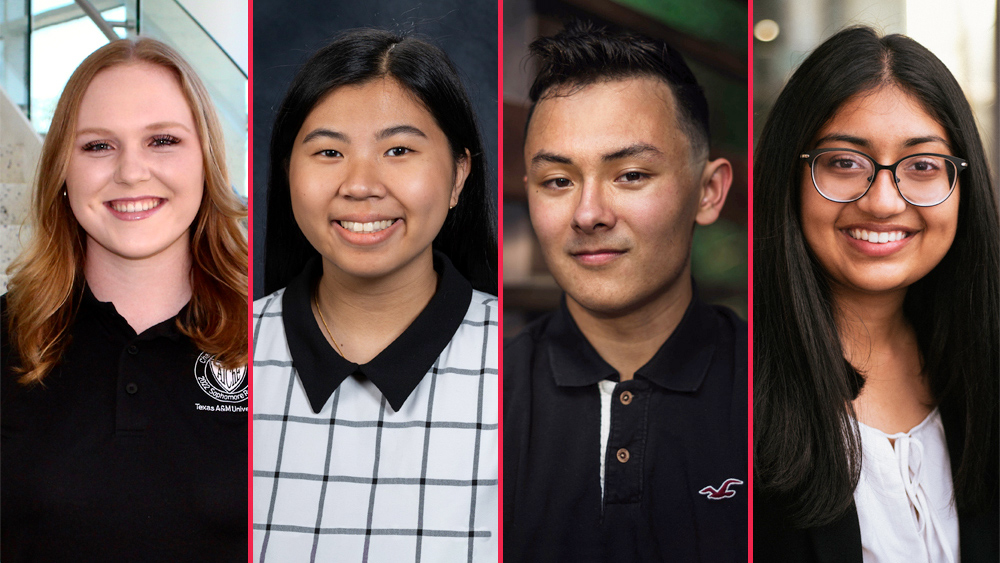
For the first time in 14 years, Texas A&M University hosted the 2023 American Institute of Chemical Engineers (AIChE) Southwest Student Regional Conference.
The two-day conference, sponsored by LyondellBasell (an international chemical company), is held annually. Students from McNeese State University in Lake Charles, Louisiana; Lamar University in Beaumont, Texas; Tecnológico de Monterrey in Monterrey, Mexico; Texas Tech University in Lubbock, Texas; the University of Texas in Austin; and the University of Houston participated in a series of workshop discussions and challenges, including Jeopardy, a poster contest and a Chem-E-Car Competition.
The competition provided an opportunity for students to showcase the research they had conducted at their respective universities. Spearheading the event for the student-led organization were undergraduate students from the Texas A&M chapter of AIChE, including the Chem-E-Car Competition chair Nathaniel Thomas, president Mikayla Canter and vice president external Andrea Afonso.
For the Chem-E-Car Competition, each participating school had a chemistry-powered car, compact like a shoebox, aiming to travel a distance ranging from 15 to 30 meters.
“The main rule was that you had to power the car using a chemical reaction,” Thomas said. “The other one was that you couldn’t use electronic timers — you had to use a chemical reaction to time the car to go a specific distance. It wasn’t about speed; it was about precision and control.”
Some of the chemical reactions included using a zinc and nickel battery that provided the power and then an iodine clock reaction, which provided the timing and the power to control the battery or provide power for the battery and a timing reaction to stop the car.
McNeese entered a hydrogen-powered car that covered the longest distance, reaching 23 meters, earning them a victory in the competition.
“Unfortunately, our team and another weren't able to get our car started because of technical difficulties,” Thomas said. “The part I enjoyed most was the competition, in terms of seeing all of the teams putting together their cars, seeing the unique designs and seeing them perform.”
After the competition, the Texas A&M team figured out the technical issue. The car had a strong potassium hydroxide solution base, and the container that held it was plastic.
“We believe there was an acid-based neutralization, which just ate away the plastic, and it neutralized the electrolyte, so the battery didn't work anymore,” Thomas said. “Then, there was also internal shorting because the structural integrity of the containers was compromised. Over time, this happened to our container.”
Initially, the chemical reaction worked well, but over time, the repeated exposures just broke down the container on the day of the competition.
Although they did not get far in the competition, Thomas said the team plans to move forward with the car at next year's competition.
“We are planning on using a modified version of our current design with a new, different battery that doesn't break down,” Thomas said. “I've also been looking at expanding our engineering teams; maybe having a second car team would make a difference.”
What the team as a whole took away from the competition was real-world experience.
“We gained a unique real-world engineering experience,” he said. “You'd be surprised how little you actually get your hands dirty as a student just going through the curriculum. Most people here are going into industry, and they haven't done any engineering at all, really. I strongly believe we need more real-world engineering experience for students today, and this is a great way to do that.”
Within the competition, the organization worked with a variety of engineering disciplines beyond chemical engineering.
"The conference served as grounds for all engineering students to learn the significant aspects of being a chemical engineer that they don't typically emphasize in our courses,” said Jennifer Ha, Southwest Student Regional Conference chair. “It gave a glimpse into what the industry is and how real-life problems are solved. Surrounded by many diverse minds, this cultivated an environment that allowed everyone to showcase their diverse ideas and also build lasting connections that we otherwise would not have. It was special to see everyone break out of their boundaries to learn and network."
The impact of the conference can be seen not only in the work the students have done but in their future careers.
“This is so important because it can be translated to my future career because everything is teamwork,” Afonso said. “Having those good relationships with the people on your team and knowing their strengths is important to efficiently run a project.”
Accompanying the career impact is the strong sense of camaraderie with other schools.
“I think the relationships I've built have been super cool, and it was great meeting everyone who came from the different schools,” Afonso said. “It was just really cool to see how we all come from different places, but we're all studying chemical engineering and have so many similar interests.”
Canter said that overall, the conference served as a valuable learning experience for the participants, fostering teamwork and collaboration within their own organizations and among other engineering groups. It provided them with fresh perspectives on diverse ideas and the ability to integrate into a unified team.
“It was rewarding to see this organization give back,” Canter said. “I know that for a lot of our coursework, we work in groups, but how to lead a team and make a team connect is not always taught that way. It's something you kind of have to learn for yourself and learn and work with the team.”